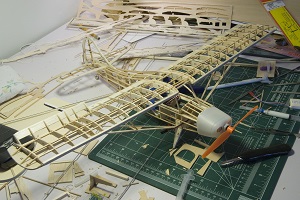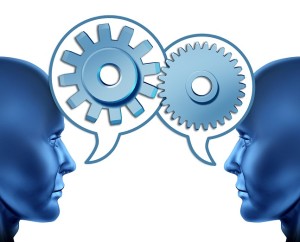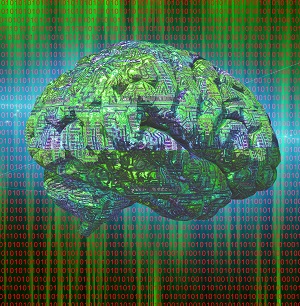30 Dec Context Models
 Building a Model
Building a Model
The goals of the research that evolved into Understanding Context were twofold:
- to investigate human physiology/psychology for clues that would let us evaluate neuromorphic computational paradigms; and
- to explore the possibility of new computational models using context to correlate and associate concepts.
Birds fly and they are lightweight. Building models of flight with lightweight materials works very well. I assume neuromorphic design is a means to improve automatic reasoning theory, not as the objective of the research. Section 6 discusses models for natural language interpretation that let computer users speak instead of typing or mousing around. With an interpreter, many more people could access information coded in computers — information that is now relatively inaccessible because of the artificial and clumsy (though improving) pseudo-languages currently used as interfaces between man and machine.
| Understanding Context Cross-Reference |
|---|
| Click on these Links to other posts and glossary/bibliography references |
|
|
|
| Prior Post | Next Post |
| DNA and Biocomplexity | Aristotle and von Neumann |
| Definitions | References |
| neuromorphic reason | Aldous Huxley |
| modeling interpretation | Tanimoto 1987 |
 Would you like to be able to carry on an intelligent conversation with your device or computer? If you could replace your keyboard and mouse with a microphone and make your system respond to spoken commands in your native language, would your computer be easier to use? Would you consider it smarter?
Would you like to be able to carry on an intelligent conversation with your device or computer? If you could replace your keyboard and mouse with a microphone and make your system respond to spoken commands in your native language, would your computer be easier to use? Would you consider it smarter?
Like, Who Cares?
Have you seen where Understanding Context is heading yet? I am proposing techniques to perform complex cognitive functions, including natural language processing.
There are three reasons for this emphasis:
- natural language processing, as an application domain, is so integrally tied to cognition that an accurate model of one must inevitably apply to the other;
- the shortage (or absence) of truly robust natural language interpretation systems is a problem in an age where access to information is becoming increasingly important; and
- it’s what the author does for a living… design/develop natural language interpretation systems.
Philosophically speaking when does a theory cease to be theoretical?
 Although most of the theories presented in Understanding Context are widely accepted and, for the most part, proven, they must still be treated with a little academic skepticism. Aldous Huxley reminds us that “facts do not cease to exist simply because they are ignored.” Another axiom that may be worth remembering is “A theory does not become a fact just because it is widely accepted.” Witness classical physics.
Although most of the theories presented in Understanding Context are widely accepted and, for the most part, proven, they must still be treated with a little academic skepticism. Aldous Huxley reminds us that “facts do not cease to exist simply because they are ignored.” Another axiom that may be worth remembering is “A theory does not become a fact just because it is widely accepted.” Witness classical physics.
The standards of evidence we require before buying into a new proposition should be fairly stiff. We must always leave our minds open to exceptions and contradictions. Alas, some academicians earn their reputation of nearsightedness. I will attempt to avoid that in my writing and attempt to show how and why context is a key component of modeling human language understanding.
Parts of the Paradigm The mechanical brain paradigm generally has three parts involving function and structure.
- FUNCTION: a mechanical brain should be able do some of the same things as a biological brain (i.e. learning, correlating, and accessing data).
- STRUCTURE: a machine would be more brain-like if its architecture (form) were similar to a biological brain (neuromorphic).
- PROCESS STRUCTURE: the intersection of function and structure where workflows and rules play with ontologies and heuristics.
All the research into, and posts regarding, the human brain and cognition are based on the premise that processes in the mechanical brain would be more likely to approach human competence if they resembled the functional steps and flow of a biological brain.
To some degree, computers have accomplished the first two parts of the paradigm. Part three is presently impossible to judge. Although there has been a lot of speculation about how the brain processes information, little has actually been proven about its information-processing steps and flow.
The following two examples of developments in computer science demonstrate progress toward solving parts one and two (function and structure) of the paradigm.
- Remembering and performing mathematical reasoning take a fair amount of intelligent human activity, and the results of that activity have been imitated by electronic calculators.
- The brain is a massively interconnected network of neurons; massively interconnected networks of artificial processors have already been produced.
Functional Evidence
 While the form or structure of the brain and its components (the subject of Sections 1-3 of the blog) provides valuable information for building a simulator or model, we also need information on the functions of the brain. The field of psychology has generated a great deal of strong evidence, much through research in artificial neural systems, from which we can infer functional properties. The psychological evidence is rooted in the writings of philosophers and cognitive scientists dating as far back as the pre-Christian era. Despite the longevity of the theory and the rigorous scientific method behind much of the research, it is still rife with speculation. The relative scarcity of hard facts is daunting, but not to such a degree that progress cannot be made.
While the form or structure of the brain and its components (the subject of Sections 1-3 of the blog) provides valuable information for building a simulator or model, we also need information on the functions of the brain. The field of psychology has generated a great deal of strong evidence, much through research in artificial neural systems, from which we can infer functional properties. The psychological evidence is rooted in the writings of philosophers and cognitive scientists dating as far back as the pre-Christian era. Despite the longevity of the theory and the rigorous scientific method behind much of the research, it is still rife with speculation. The relative scarcity of hard facts is daunting, but not to such a degree that progress cannot be made.
Cognitive Physiology poses and answers a host of applicable questions. In order to avoid the classic trap of trying to build something before we know what we want at the end, we seek here to understand human cognition as a model from which we can derive clues to help us build a better mousetrap.
One way to specify a better computational model is to use an analytical approach. This is done by analyzing the functions of the parts of the brain to define a cognitive physiology. I will proceed to post some questions that can be answered from the fields of biology and psychology. The resulting information is critical in trying to specify the architecture of a neuromorphic computer or algorithms for a neural network that can perform artificial intelligence applications.
| Click below to look in each Understanding Context section |
|---|
| 1 | Context | 2 | Brains | 3 | Neurons | 4 | Neural Networks |
| 5 | Perception and Cognition | 6 | Fuzzy Logic | 7 | Language and Dialog | 8 | Cybernetic Models |
| 9 | Apps and Processes | 10 | The End of Code | 11 | Glossary | 12 | Bibliography |








